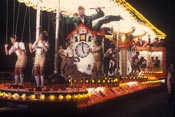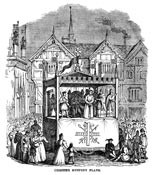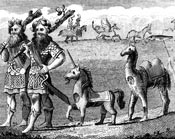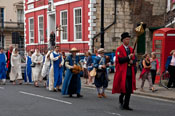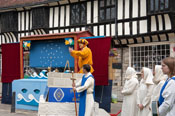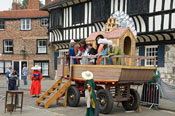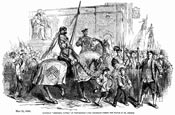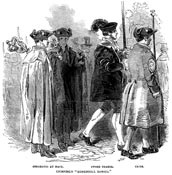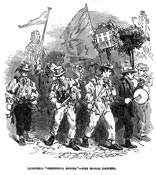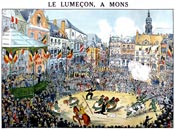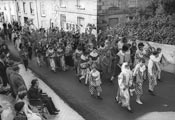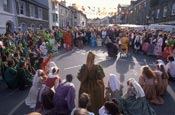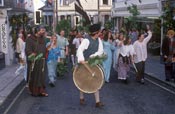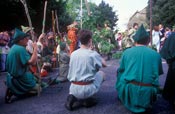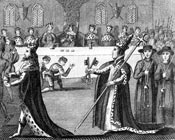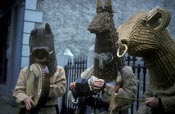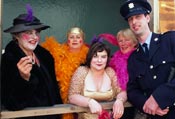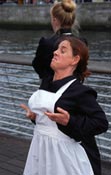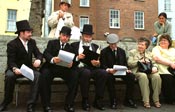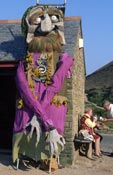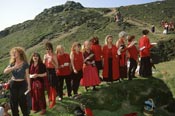
Finally some role playing of different kinds, in pageants, carnivals or re-enactments. Bridgwater Carnival, now on the Saturday nearest 5 November, originally to do with Guy Fawkes and featuring a huge bonfire and a torchlight procession, has morphed into Britain’s biggest lightbulb extravaganza with numerous ‘carts’, some 100ft long and lit by tens of thousands of bulbs. A similar number of walking groups represent themes, stories, or ideas. The spectacular procession takes a couple of hours to pass by. Bridgwater is the biggest of more than thirty carnivals in the West Country between mid-August and the end of November. The Mystery Plays were developed in medieval times and were performed, in the vernacular of the time, by the city craft guilds. The name ‘Mystery’ is thought to be derived from the Latin ‘misterium’ meaning ‘work’. The plays were ‘cycles’ of bible stories, each one presented by a different guild. The mystery, or miracle, plays flourished for centuries until they were banned by the Church in the 15th century. Though some interest was shown subsequently it was not until the Festival of Britain in 1951 that any were revived in their original form, though translated into modern English. Chester performed their complete cycle of 24 plays and have repeated them at five year intervals ever since. Both Britten and Stravinsky turned Chester’s Noah’s Flood episode into operas. York revived their complete cycle of 48 plays but as they involve so much organisation confine them to special occasions, such as the Millennium and the recent ‘Cultural Olympiad’ of 2012.
Courts of Arraye go back to the 12th century when Henry II decreed that all free men in England between 16 and 60 should be available to bear arms if required, and turn out to be counted every Whit Monday. In Lichfield the annual muster took place at ‘Greenhill Bower House’ – and there is still a military element in the events there on Spring Bank Holiday - and a huge procession, funfair, games and the inevitable ‘Bower Queen’. Le Lumeçon is part of an elaborate festival in Mons, Belgium, featuring St George and the Dragon, not really relevant here, but the dragon is notably absent from most English folk plays even if they feature St George. The Hal-an-Tow pageant on Flora Day in Helston comes between the Early Morning and Children’s Dances and is a controversial singing and acting out of the traditional Cornish Hal-an-tow song, ‘revived’ by the Old Cornwall Society about 1930 (we concede this makes it pretty authentic!) but it has little to do with the magnificent Furry Dances which are the main feature of the day.
Collections confesses to being quite unable to read James Joyce’s famous novel ‘Ulysses’, in spite of having been born in Dublin where all the action takes place. It covers a day, 16 June 1904, in the life of Leopold Bloom, and his wife Molly, as they move about the city. The book was published in 1922 and is of such complexity that Dublin literati have been arguing about it ever since. In 1954, to commemorate the fiftieth anniversary of the day immortalised in the book, a group of them devised ‘Bloomsday’ in which they would follow Bloom’s progress and read sections of ‘Ulysses’ at the appropriate time and location. The first Bloomsday ended early, but in traditional Irish fashion, when they all got drunk and their literary discussions got seriously out of hand. Still, they returned the next year regardless and Bloomsday has since developed into a major annual event in Dublin. Bolster was a giant who ate children in Cornwall, but fell in love with a girl called Agnes who managed to trick him into bleeding to death. The people of St Agnes have recreated the legend every May Day since 1992.
